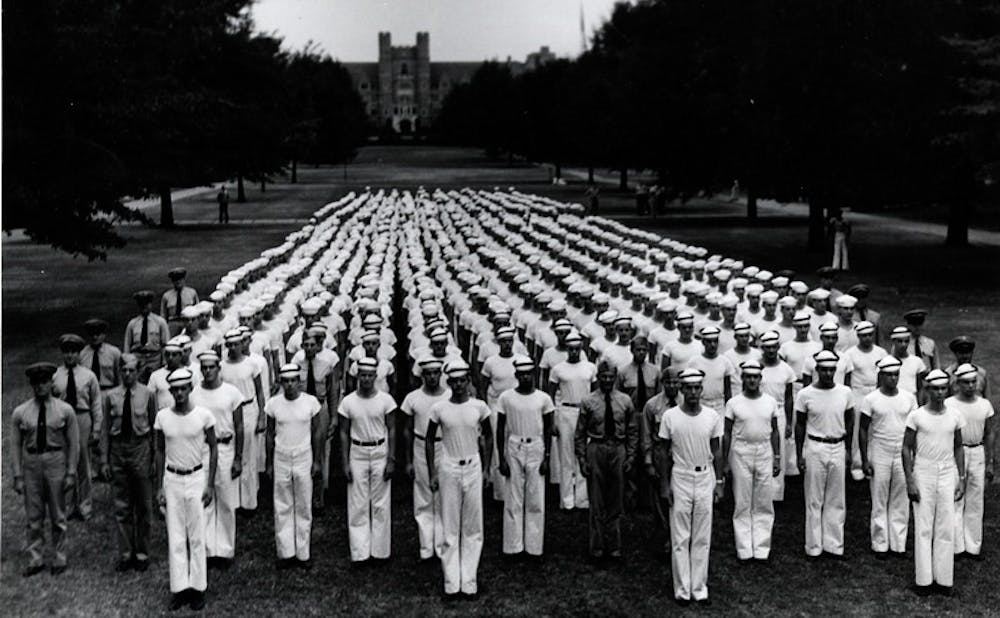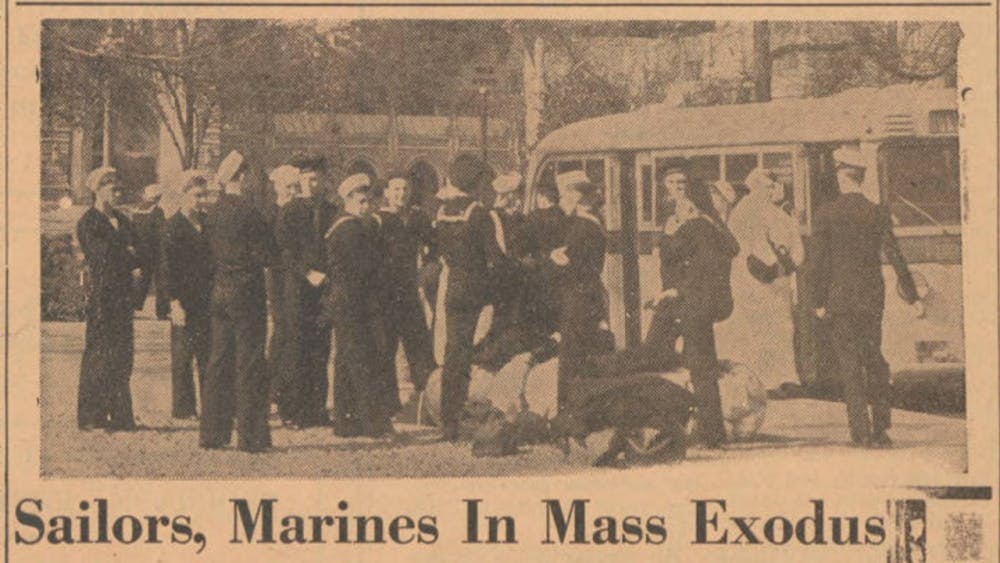Editor's note: This story is the second entry in a series called Flashback, which The Chronicle will be running online weekly through the end of the summer. We welcome readers' input about old stories they would like to see featured.
This week's story focuses on the members of the Duke community who left Durham to fight in World War II—including the hundreds who did not return—in honor of Memorial Day.
Students boarding the bus is a familiar sight at Duke’s Chapel bus stop. But for these young men, their final destination was not East Campus.
In the 1940s, many Duke students participated in the Naval Reserves Officers Training Corps, forming a large part of the University’s Navy V-12 unit. On November 5, 1943, The Chronicle reported on the “mass exodus” of Duke sailors and marines who were leaving for active duty to fight for the United States in World War II.
“By bus and by car, by train and by plane, over four hundred students left the university last week,” Michael Josephs wrote in the article. “It was an impressive sight indeed to see them stand at attention in long lines along Duke’s once-peaceful campus while sergeants and Chief Petty Officers barked their last orders.”
Some students were headed to temporary stations like Paradise Creek, Va. or officer training in Parris Island, S.C. But, the majority was shipped to San Diego, Calif., “with the South Pacific seemingly the next step in their journey,” Josephs reported.
He wrote that for some students “it was a forced farewell” though “for others it was voluntary." But for all, he noted, it was “an abrupt ending to their college careers.” Less than one-fifth of the students received their diplomas before leaving, Josephs added.
“To educational observers this incomplete education heralded a problem that will rise to major significance after the war when thousands of soldiers, sailors, and marines flood back to college to complete their education,” Josephs wrote.
Even in 1943, there were concerns for student soldiers who put their education on hold to serve their country.
Josephs noted that “steps were already being taken to prepare” for the influx of postwar veterans, alluding to the passage of the Servicemen's Readjustment Act of 1944. Commonly called the GI Bill, this act provided veterans with funding to finish their college educations.
“For many a student who saw Duke for the last time the other day, this may well have been a hope for the future,” he wrote.
As Duke students headed off to war, The Chronicle kept track of their journeys in a column titled “Duke In The Service,” which ran from 1944 to 1945. The column featured quotes and updates from letters that alumni secretary Anne Garrard received from students and alumni.
Their stories ranged from the courageous—pilot Paul Horton, ’44, was awarded the Air Medal—to the absurd—Hode McAllister, ’44, supervised the construction of a cowboy bar near his base.
All offered a glimpse into the daily lives of student soldiers at war.
“Our first mission turned out to be on a beach-head in the Palaus [Islands in the Pacific Ocean]. As our particular job is to make the initial landing of troops on the beach, we carried in the first six waves of troops,” wrote David Huston, ’45, whose letter was featured in the column in December 1944. “I imagine there have been tougher fights than ours on that day, but it was far from being a pleasant incident!!”
However, in addition to student stories, the column also reported on the deaths of Duke students and alumni. On May 5, 1944, the column reported that Royal L. Beede, ’44—who had joined the Maritime Service in 1942—had died.
Beede was one of more than 230 Duke students and alumni who died in service to their country over the course of WWII.
A memorial to honor Duke's WWII dead—located on a wall between the Chapel and the Divinity School—was installed in 1993. Later in 2009, fifty-four more names were added to the existing wall to honor the sacrifice of Duke alumni who died during active military duty since 1945, including those who served in Korea, Vietnam or Iraq.
Former Veteran Affairs Secretary Eric Shinseki, Graduate School '76, spoke at the re-dedication ceremony in 2009.
"Duke has many distinguished alumni, but I'd argue that the names on this memorial represent the most distinguished," Shinseki said. "They represent extraordinary courage and dedication in the face of great adversity. This memorial affirms that free people can bend history in the direction of our best hopes, and ensure that their service and sacrifice will never be forgotten."

Get The Chronicle straight to your inbox
Signup for our weekly newsletter. Cancel at any time.

